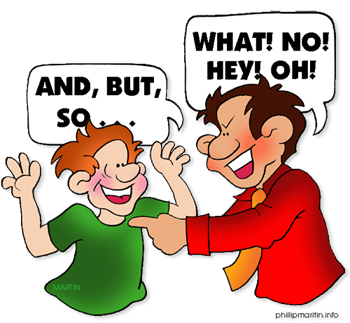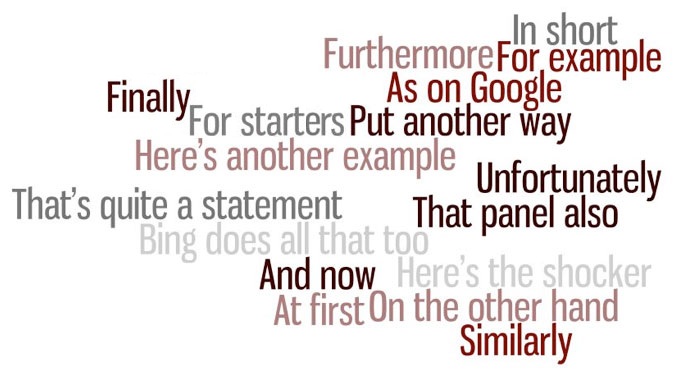Transitional Words and Phrases
News Flash: It is not the reader’s job to try to make sense of your writing; it is your responsibility to make your writing understandable. Transitional words and phrases act as signals to help you accomplish that task. Consider the following two sentences: Beth is the fastest runner on the team. She finished in last place at the track meet. Did the contradiction between them make you stop and think? The first sentence obviously doesn’t flow smoothly into the second one because there is a break in logic. Now put the simple transitional word but between the sentences, and you have Beth is the fastest runner on the team, but she finished in last place at the track meet. The addition of but acknowledges the inconsistency and even gets the reader ready for it.

Source: Conjunctions, Phillip Martin
Transitional words and phrases emphasize the relationships between ideas, move readers from one idea to the next, and give them hints of what to expect in the sentence or paragraph. Put another way, transitions help readers follow your thinking or see connections they might either gloss over or misunderstand.
So is there a definitive list of these transitional words and phrases? In a word, no. There are, however, numerous lists of transitions categorized in slightly different ways. (For an extensive, two-page list, go to Transitional Words, and print or bookmark a copy to refer to.)
The goal isn’t for you to memorize a list, though. The object is for you to be knowledgeable about the range of transitional words and phrases so that you can use them to make your writing more coherent.
Let’s look at examples of sentences using a few of the transition classifications. Notice that most transitional words and phrases are at the beginning of a sentence, but some may appear after the subject or at the beginning of a second or subsequent independent clause in the sentence.
Time transition: We arrived at the party late. Immediately the hostess scolded us for our tardiness. (You could also use a semicolon: “We arrived at the party late; immediately the hostess scolded us for our tardiness.”)
Addition transition: Sharon announced that she was leaving home, and she wasn’t kidding.
Comparison transition: The king walked slowly to the throne and took his rightful seat. In similar fashion, the queen made her way to the smaller throne.
Contrast transition: Derrick’s strategy brought victory to his team. Ted’s plan, however, was not as successful.
Example transition: My anatomy class is really difficult. To illustrate, 80% of the students are failing.
Place transition: I was so scared that I began to look for an escape route. Above, a ray of light came through the trees.
In the interactive exercise below, use the pull-down menu to classify the transitional words. The feedback will show up on the bottom left of the exercise.
Using transitional words and phrases isn’t just a gimmick to help you write better papers; it actually is a key element of successful writing on all levels. We’ve looked at transitions between sentences, but now let’s think about transitions that connect paragraphs to each other. For that, we’ll switch gears and use a professional piece, a New York Times article entitled “Bing, the Imitator, Often Goes Google One Better.” The author, David Pogue, wrote 34 short paragraphs—newspaper style calls for them to be short—comparing the two search engines, and here are the transitional words and phrases at the beginning of 20 of those paragraphs:

Source: New York Times transitional phrases, IPSI
Even without reading the article, you can tell that the author was consciously connecting his paragraphs so that readers could easily move from one to another.
Read Pogue’s interesting article.
Now that you’re more aware of the power and function of transitional words and phrases, you need to use them wisely. You know the result of not using enough transitions: disjointed, confusing writing. However, the result of using too many of them is just as bad: formal, artificial-sounding writing.
When editing your essays, first look for transitional elements between sentences in paragraphs; then look at the beginnings of paragraphs. If transitions are not evident much of the time, you may need to add some to hold your ideas together. Be careful to use correct transitions, though, because the wrong ones can lead readers astray and cause confusion rather than promote understanding. For example, think how bewildered a reader would be if the sentence at the beginning of this section read Beth is the fastest runner on the team; thus, she finished in last place at the track meet. Learn to use a wide range of transitions, not just a few, but also keep in mind that some of the best transitions are the simplest ones.